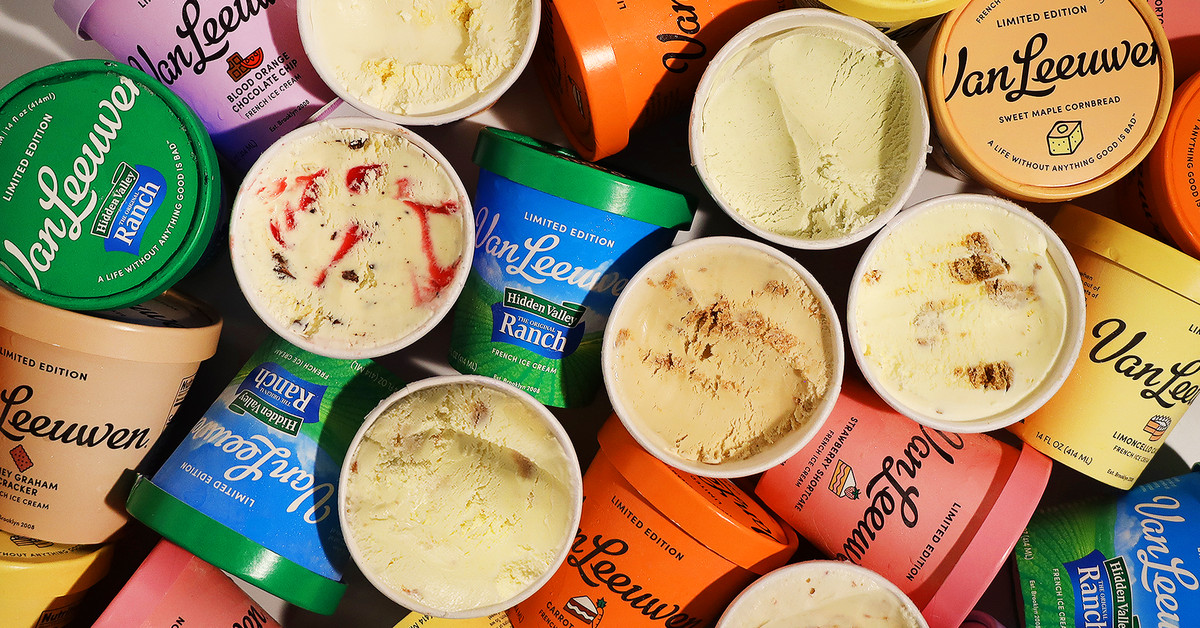
Too often in human history (and in Jurassic Park), we ask ourselves, “Can we?” when the real question worth asking is, “Should we?” Little else embodies this sentiment better than what is currently the bane of my existence as a person with taste buds: the latest wave of attention-grabbing ice cream flavors and collaborations.
Shockingly few things are as universally beloved and unproblematic as ice cream. It’s an ideal canvas for creative chefs and burgeoning entrepreneurs, a vehicle for unfamiliar flavor combinations, a welcome respite for even the pickiest eaters, and a soothing vessel of summertime and childhood nostalgia. It’s basically a guaranteed crowd-pleaser. However, ice cream has been going off the rails.
From Jeni’s shortbread-inspired pints celebrating the premiere of Ted Lasso’s third season and Van Leeuwen’s onion-based Glass Onion monstrosity to trending flavors like ranch or Kraft macaroni and cheese, things have gotten more than a little weird in the dairy department. And while some of these experiments have been surprisingly successful (looking at you, Kraft), many of them have haunted both my mind and stomach.
This whimsical approach to unexpected ice cream flavors isn’t new. But lately, it seems we’ve lost the thread in terms of what made these collaborations so invigorating, so exciting, so delightfully unserious in the first place. So, in an unapologetically selfish plea to the powers that be, I’ve laid out some simple requests for the future flavors sure to drop as part of whatever marketing stunt comes next.
Many limited-edition riffs go wrong right out of the gate by overpromising. These attempts try to be so clever that they end up missing the point, and failing to deliver on their flavor’s initial promise. If the ice cream in question promises to be sweet, why chock it full of unbalanced salt or bitterness, or a string of “buzzy,” viral ingredients? Or, if advertising a “mystery flavor” like Van Leeuwen’s totally not obvious Glass Onion flavor — which combined bourbon, caramelized onion jam, honeycomb, and greek yogurt — maybe consider ingredients that call back to the film without incorporating enough onion jam that even paid actors struggled to convince viewers they enjoyed the experience?
Of course, people should be free to experiment with ingredients, but when the end result is the furthest thing from the initial promise (a damn good pint of ice cream, sweet, savory, or whatever), it’s time to acknowledge that we may be flying a bit too close to the sun here.
But that doesn’t mean the ice cream should be an untouched translation of its inspiration in dairy form. Take, for example, that lovely, little, night terror: Van Leeuwen’s Hidden Valley ranch ice cream. In theory, ranch dressing ice cream sounds off-putting, but it’s a combination rife with potential. (After all, there has to be a reason people put it on everything.) But, that potential was never realized since the pints mimic the experience of consuming ranch so closely that, if not for the texture, it’d be more at home on a salad than in my freezer.
That ice cream, like Baskin-Robbins’s recent Chick’n & Waffles flavor and so many others, seemed to be an obvious attempt to vie for social relevance without the real intention of doing something adventurous — or merely good — with its flavors. (I love chicken and waffles as much as anyone, so why not aim for a flavor that goes beyond a combination of buttermilk, sugar, and ample glugs of maple syrup?) Which leads to the real issue at hand: Many of these collaborations feel like they’re more focused on creating a stunt for shock value than actually making ice cream that’s nuanced, complex, or just plain fun. Sure, I know that these flavors keep being made because consumers keep buying them and reacting to them (or… uh, writing about them), but what happened to the whimsy that once seemed to be at the core of these exploits?
Shops like Malai, Houston’s Craft Creamery, Portland’s Salt and Straw, and even Van Leeuwen and Jeni’s when they’re at their best do creative ice cream right. But the root of when and why their flavors succeed lies in the approach: the flavors actually taste like intentionally well-made ice cream flavors strong enough to stand on their own, rather than the byproduct of the latest publicity stunt. They’re not just butter stripped from a glorified shortbread recipe or quirky ideas brought to half-life. They’re flavors that successfully signal the dishes or media they’re drawing inspiration from, while still being daring enough to abandon that inspiration enough to take on a life of their own.
Jeni’s release of Dolly Parton’s Strawberry Pretzel Pie ice cream is the gold standard here. Sure, the ice cream combined things that were already pretty adored to begin with (Dolly Parton, Jeni’s, and a classic Southern dessert masquerading as a salad). However, the real ingenuity lies in the ice cream’s ability to taste like strawberry pretzel salad while leaning into creamy, measured sweetness and just enough salt to keep the potentially too-sweet dessert from being overly reminiscent of its Jell-O-topped origins. There’s a host of reasons the flavor sold out in minutes during its first release — and was brought back in 2022.
So while I’ll still gleefully try the breadth of ingenious new ice cream creations from the wide variety of people and shops who are consistently coming up with their wackiest, what-if flavors, I’ll have to sit out on the brand stunts for a while. At the end of the day, I’m still a lactose-intolerant ice cream lover, which means I don’t need ice cream to antagonize me more than it already does.
